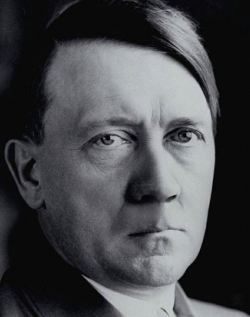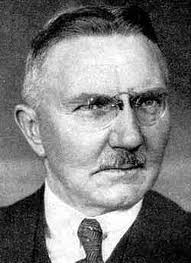"The myth of Nazi anti-Usury activism is damaging, not only because of its mythological character, but because it allows the Money Power to defame anti-Usury activism through 'guilt by association'. In fact, many Austrians and Mainstreamers, call usury-free monetary reform programs 'fascist'. Fascism itself is being rehabilitated because of its supposed stance against finance capitalism."
 (Left: The Emperor has
no mustache......)
(Left: The Emperor has
no mustache......)
The widespread notion that Hitler
created debt-free credit is erroneous.
The German taxpayer continued to
pay interest on the substantial national debt and commercial
banking largely financed the war at interest.
"Schacht's policies did absolutely
nothing to limit massive war profiteering by the financial and industrial
classes that brought Hitler to power."
By Anthony
Migchels
Despite his pledges, Hitler
did not implement any serious monetary reform after he came to power. He did
make finance completely subservient to the State and, more specifically,
rearmament. But he did not nationalize any banks. The Reichsbank was already
nationalized by the Weimar Republic. He did not end interest payments to 'the
issuing houses', who must have made a fortune throughout the war. He did nothing
to decouple the Stock Exchange from the economy.
Hjalmar Schacht became Reichsbank
President in August 1934. Schacht's policies allowed full control of the economy
to maximize production for war. But it did absolutely nothing to limit massive
war profiteering by the financial and industrial classes that brought Hitler to
power. Hitler used the monetary system that he inherited from the Weimar
Republic. The Reichsmark, like any other banking unit, was lent into
circulation.
 WHO WAS HJALMAR
SCHACT?
WHO WAS HJALMAR
SCHACT?
Schacht was born in 1877, the son of
an aristocratic family. He joined Dresdner Bank in 1903 and by 1905 was meeting
people like JP Morgan and Theodore Roosevelt. He studied Hebrew to advance
his career. In 1908 he joined Freemasonry. He oversaw the financing of
Belgian/German trade during WW1 and used his former employer Dresdner Bank for
this. This blatant conflict of interest led to his dismissal, but he was taken
back by Dresdner Bank after this.
In 1923 he joined the Reichsbank and
played a key role in ending the hyperinflation of the day. A little later he was
made President of the Reichsbank and remained in this post until 1930. Since at
least 1923 he actively resisted the war reparations that were destroying the
German economy and called for resurrection of German power. In 1926 he became
involved with the NSDAP and supported their rise to power, although he never
became a member.
He oversaw the formation of I.G.
Farben in the twenties.
Schacht was a member of the Keppler Circle, a
small group of businessmen that were at the heart of the Nazi movement and which
financed Hitler's rise to power. Wall Street was very influential in this group
and contrary to what many Hitler apologists claim, played a heavy role both in
financing him and in war profiteering.
Shortly after Hitler came to power,
he was reinstated as President of the Reichsbank and basically gained full
control over the economy. This lasted until he was fired in 1939, when the
German economy was overheating and Schacht wanted to limit spending on
rearmament and was accused of 'mutiny' by Hitler.
MEFO
Schacht created a special purpose
vehicle (SPV, a dummy corporation) called MEtallurgische
FOrschungsgesellschaft (MEFO), which was used to accept bills of exchange
drawn by German weapons manufacturers and received by all German banks for
possible re-discounting by the Reichsbank. The bills were guaranteed by the
Reich for five years and were thus (indirectly) convertible to
Reichsmark.
While they solved the depression and
allowed for the Nazi war machine, they also created fairly serious inflationary
pressures. And while this kind of construct may sound 'innovative' to the
uninitiated, they would have been a no brainer for an experienced banker like
Schacht. As said, they were based on certificates (called Oeffa) that the Weimar
Republic was already circulating and national treasuries had been circulating
their own certificates routinely, when pressing political issues forced them to
increase their financial clout. The US Treasury had its Treasury notes before
the Civil War. The UK printed 'Bradbury Pounds' (debt free notes) to finance
WW1. The Canadian Treasury printed its own debt free money as of 1935 and during
the twenties and thirties advanced monetary reform programs were widely
discussed throughout the West.
There was no usury-free economy. The
common man or small business actually would have next to no access to credit at
all. Even manufacturers were forced to become self financing, so the State could
monopolize borrowing on the capital markets. The stock market boomed like never
before.
Instead, all policies were directed
at securing sufficient funds for rearmament, not at minimizing financial
exploitation by the parasitical class that Hitler so vehemently attacked with
his rhetoric. Finance was a matter of volume, not cost.
Schacht's MEFO bills have been
wrongly jumped upon to claim Hitler was an anti banker man, while Schacht
himself has the typical bio of a high level Money Power operative. He was a life
long friend of BoE chief Montague Norman and was acquitted at Neurenberg, where
the Soviets wanted a conviction while the British made sure he was
released.
The myth of Nazi anti-Usury activism
is damaging, not only because of its mythological character, but because it
allows the Money Power to defame anti-Usury activism through 'guilt by
association'. In fact, many Austrians and Mainstreamers, call usury-free
monetary reform programs 'fascist'. Fascism itself is being rehabilitated
because of its supposed stance against finance capitalism. But as we have
learned from Bolton's 'The Banking Swindle', the twenties and thirties
saw many monetary reform programs throughout the West, far from all associated
with fascism. After the war they were relegated to a memory hole because of this
false association with fascism.
War profiteering by the industrial
and financial class was in no way restricted. As a result, they profited
immensely from the war. This was indeed the main reason for them to enable
Hitler's rise to power and their loyal support of his policies during the
rearmament and the war. Even today, the main culprits like the Thyssen family,
Krupp and the Goebbels step-children owning BMW are among the richest people in
Germany. The same banks that financed the Reich's war are now among the biggest
in the world.
(with special thanks to Niels
Verduijn and Ad Broere)
Anthony
Migchels is an Interest-Free Currency activist and founder of the Gelre, the
first Regional Currency in the Netherlands. You can read all of his articles on
his blog Real
Currencies
Sources:
Hitler
and the Banksters, by Ingrid Rimland
Nazi War Financing and
Banking, by Otto Nathan
Jewish
Virtual Library on Schacht
Wall
Street and the Rise of Hitler, by Antony Sutton
Related: